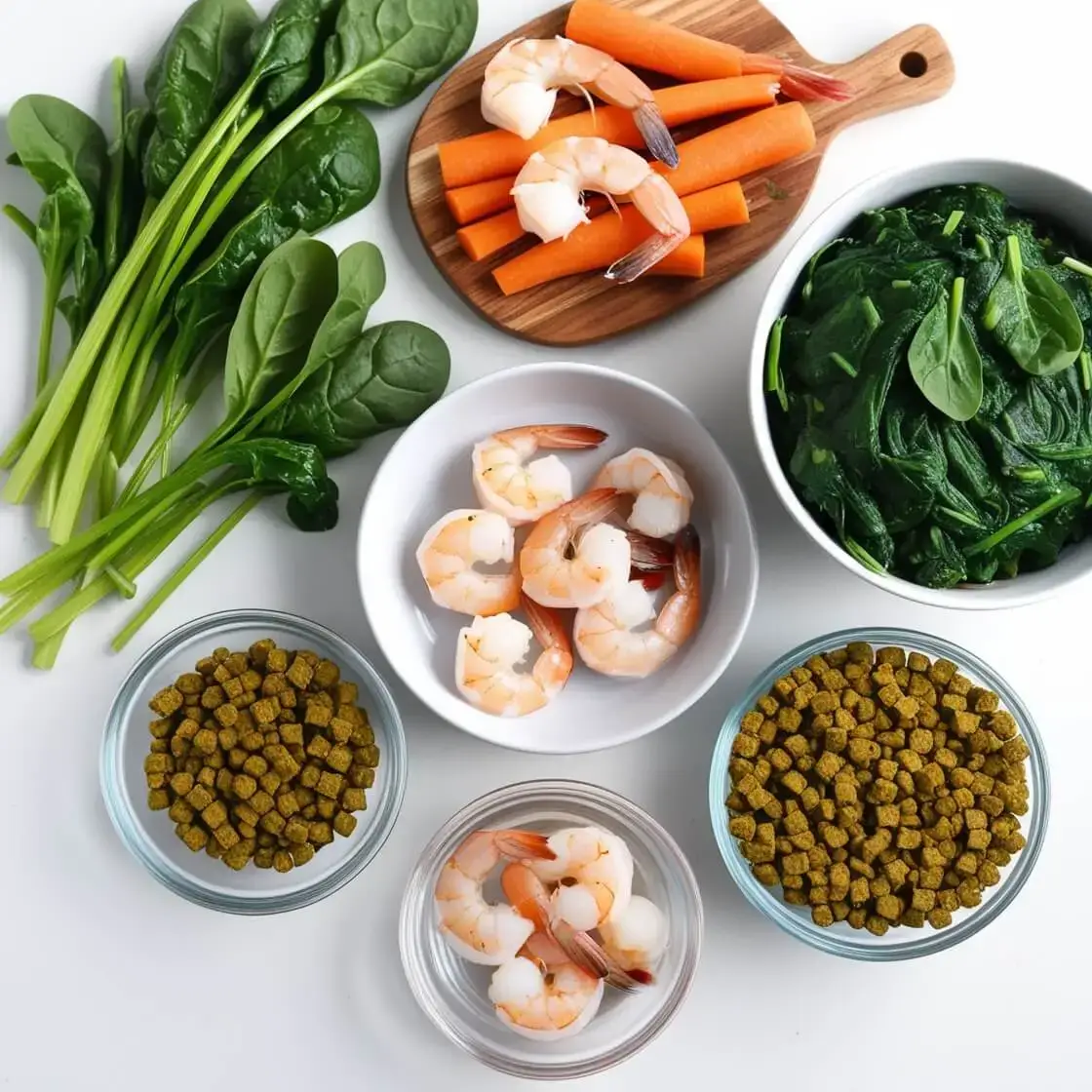Introduction
Fishkeeping can be an incredibly rewarding hobby, offering a sense of tranquility and connection with nature. However, maintaining a healthy and vibrant aquatic environment requires careful attention to several key factors. Among these, providing the right nutrition stands out as one of the most crucial aspects of fish care. While store-bought fish food is a convenient option, it often lacks the customization and nutritional benefits that homemade alternatives can provide.
Preparing the best homemade food for fish not only allows you to control the quality and ingredients but also ensures your aquatic pets receive a healthier and more balanced diet tailored to their specific needs. Additionally, homemade fish food can be a cost-effective and creative way to enhance your fishkeeping experience, enabling you to experiment with fresh, nutrient-rich ingredients that contribute to your fish’s overall well-being.
In this comprehensive guide, we will dive into the advantages of making your own fish food, share expert advice on selecting the right ingredients, and provide simple, easy-to-follow recipes to get you started. By the end, you’ll have all the tools and knowledge to prepare the best homemade food for fish, giving your aquatic companions the nutrition they deserve while taking your fishkeeping hobby to the next level.
Check out our step-by-step guide on How to Make Homemade Fish Feed to keep your fish healthy and thriving
Why Homemade Fish Food Is the Best Choice for Your Fish
When deciding between store-bought and homemade fish food, it’s essential to consider the numerous benefits of preparing your fish’s meals yourself. The best homemade food for fish offers unparalleled flexibility, allowing you to tailor recipes to your fish’s specific needs while also providing significant advantages in cost, nutrition, and sustainability.
1. Cost Savings of Making Fish Food at Home
One of the most compelling reasons to prepare homemade fish food is the cost savings. Store-bought fish food can become expensive over time, particularly for larger aquariums or specialized diets. By making your own, you can use ingredients already in your kitchen, such as vegetables and proteins, reducing expenses. Additionally, homemade fish food can be prepared in large batches and stored for extended periods, offering a budget-friendly solution that doesn’t compromise quality.
2. Nutritional Benefits of Homemade Fish Food
Homemade fish food ensures that your fish get precisely what they need for optimal health. Many commercial options are filled with additives and fillers that don’t provide much nutritional value and may not suit all species. With the best homemade food for fish, you can include high-quality proteins, fresh vegetables, and essential nutrients tailored to your fish’s dietary requirements, promoting their well-being and longevity.
3. Avoiding Additives in DIY Fish Food
Another reason to switch to homemade fish food is the absence of artificial preservatives and colors. These additives, which are common in commercial fish food, can have long-term negative effects on your fish’s health. Instead, homemade options allow you to provide natural, wholesome meals.
4. Eco-Friendly Benefits of Homemade Fish Diets
Finally, by making your own fish food, you reduce packaging waste. This eco-friendly approach not only benefits your fish but also helps the environment.
Essential Ingredients for the Best Homemade Fish Food
Once you decide to make fish food at home, the next step is understanding the essential ingredients. To create a well-balanced diet, you need to include a mix of proteins, vegetables, and binders.
1. Protein Sources
Since fish need protein to thrive, you should prioritize high-quality sources. For example:
- Fish or Shrimp: These are natural and provide essential nutrients.
- Egg Yolk: Ideal for young fish and fry, as it is rich in protein.
- Worms or Insects: These mimic a fish’s natural diet and are easy to find.
2. Vegetables
In addition to proteins, many fish benefit from plant-based nutrients. Vegetables not only add variety but also improve digestion. For instance:
- Spinach and Zucchini: These are excellent for most species.
- Peas: Known for relieving constipation in fish.
- Algae or Seaweed: Essential for herbivorous fish.
3. Binders
To keep the food intact, you will need binders like:
- Gelatin: A common and safe choice.
- Agar-Agar: A plant-based alternative that works equally well.
4. Supplementary Additions
To round out the recipe, consider adding:
- Omega-3 Oils: These promote healthy fins and vibrant colors.
- Vitamins and Minerals: Ensure a balanced diet for long-term health.
How to Make DIY Fish Food at Home: Step-by-Step Guide
At first, making fish food at home may seem daunting. However, with a simple step-by-step process, you can easily prepare nutritious meals for your fish.
1. Gather Your Ingredients
To begin with, collect fresh ingredients that suit your fish’s dietary needs. For instance, carnivorous fish require more protein, while herbivorous species need extra greens.
2. Blend Ingredients Together
Next, combine all the ingredients in a blender. Start with the proteins, then gradually add vegetables and binders. By blending thoroughly, you ensure a uniform mixture that is easy for your fish to eat.
3. Form the Food
After blending, shape the mixture into pellets or flakes. Alternatively, pour it into molds to create specific shapes. If you prefer, you can also freeze the mixture for later use.
4. Preserve and Store
Once the food is ready, store it in airtight containers. To keep it fresh, refrigerate small portions or freeze larger batches. This ensures the food retains its nutritional value.
5. Feeding Tips
When feeding your fish, remember to start with small amounts. Not only does this prevent overfeeding, but it also keeps your tank clean. Observe your fish’s behavior and adjust portions as necessary.
Customizing Homemade Fish Food for Different Species
Although all fish need a balanced diet, their specific requirements can vary greatly. Therefore, it is important to customize your homemade food based on the species you are feeding.
1. Tropical Fish
For tropical fish, a mix of proteins and plant matter is ideal. For example, you can use shrimp, egg yolk, and spinach to create a balanced meal.
2. Herbivorous Fish
In contrast, herbivorous fish thrive on plant-heavy diets. Ingredients such as algae, zucchini, and peas are excellent choices.
3. Carnivorous Fish
On the other hand, carnivorous fish require high levels of protein. Fresh fish, worms, and insects are some of the best options for these species.
4. Bottom Feeders
Finally, bottom feeders benefit from sinking foods. By adding gelatin or agar-agar, you can create food that naturally settles at the bottom of the tank.
Common Mistakes to Avoid When Making Homemade Fish Food
Although making fish food is simple, there are several mistakes to avoid. By addressing these issues, you can ensure your fish remain healthy and happy.
1. Overfeeding
First of all, avoid overfeeding your fish. Too much food can lead to water contamination and health problems. Always start with small portions and increase as needed.
2. Ignoring Species Needs
Secondly, do not assume all fish have the same dietary requirements. Research your species to provide the best possible nutrition.
3. Using Harmful Ingredients
Additionally, steer clear of toxic ingredients such as onions or garlic. Even in small amounts, these can harm your fish.
4. Skipping Proper Storage
Lastly, improper storage can spoil your homemade fish food. Always use airtight containers and store food in a cool, dry place or freeze it for extended use.
Conclusion
In conclusion, preparing the best homemade food for fish comes with numerous advantages, from improved nutrition and customized diets to reduced waste and cost savings. By taking the time to understand your fish’s dietary needs and experimenting with different recipes, you can create meals that are not only healthy and balanced but also perfectly suited to their species.
Moreover, making homemade fish food allows you to ensure that only fresh, high-quality ingredients go into their diet, contributing to their overall health and longevity. It’s an excellent way to enhance your fishkeeping journey while fostering a deeper connection with your aquatic pets.
Now that you have all the essential information, there’s no better time to try making your first batch of the best homemade food for fish. With a little effort and creativity, you’ll provide your fish with meals they’ll thrive on, and they’ll reward you with vibrant colors, energetic behavior, and a lively aquarium environment. Your fish will surely thank you for the care and attention you put into their nutrition!
What are your favorite DIY fish food recipes? Share your tips and experiences in the comments below!
FAQs
What is the best homemade food for fish?
The best homemade food for fish consists of a balanced mix of protein and vegetables. Ideal protein sources include shrimp, fish, and other seafood, while vegetables like spinach, peas, or zucchini provide essential vitamins and minerals. To create a cohesive texture, use a binder such as gelatin, which helps shape the mixture into pellets or flakes. This approach ensures that your fish receive a nutrient-rich diet tailored to their needs, making it the best homemade food for fish.
What are the best ingredients for fish food?
The best ingredients for homemade fish food are those that mimic your fish’s natural diet. Protein sources like shrimp, fish, or egg yolks provide the essential building blocks for growth and health, while vegetables such as spinach, peas, or carrots offer necessary vitamins. Binders like gelatin help maintain the structure of the food, and adding supplements like omega-3 oils or spirulina can boost nutrition further. By selecting fresh, high-quality ingredients, you can create the best homemade food for fish that promotes their well-being.
How to make homemade fish feed?
Making homemade fish feed is a simple and rewarding process. Start by blending fresh vegetables, protein sources, and a binder like gelatin into a smooth mixture. Shape the blend into pellets or flakes, depending on your fish’s preferences, and allow it to set. Store the food in airtight containers in the refrigerator or freezer to maintain freshness. Feeding your fish small portions ensures they receive the best homemade food for fish while avoiding overfeeding.
What is the best food to feed my fish?
The best food for your fish depends on their species and dietary requirements, but a mix of protein and vegetables is a great starting point. Shrimp, fish, and spinach or peas are excellent choices for a balanced diet. Homemade fish food made from fresh, natural ingredients is particularly beneficial as it allows you to customize the diet for your fish’s needs. This personalized approach ensures your fish thrive with the best homemade food for fish, contributing to their health and vibrant appearance.

